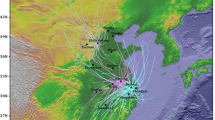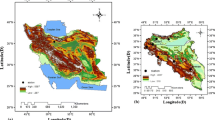Abstract
Atmospheric dust loadings strongly depend on the amount of dust emissions and on the atmospheric variability. This study examines trends in PM10 (i.e., a particulate matter with the aerodynamic diameter equal to or less than 10 μm) mass concentrations for South Korea with respect to the East Asian atmospheric variability due to climate warming. The PM10 mass concentrations were used by the nationwide monitoring network of the Korean Ministry of Environment (KME) over the two-decade period of 1999–2018. Annual PM10 in South Korea was found to decrease to −0.61±0.08 μg m−3 yr−1 over the two decades of 1999–2018. Such an overall decrease was more associated with a decreasing trend during spring and summer than during other seasons. An empirical orthogonal function (EOF) analysis of wind speed at 850 hPa accounted for the spatial structure wherein the decrease of wind speeds in Mongolia and China was consistent with those in South Korea during the spring season. Furthermore, the next highest PM10 reduction rate during the stagnant and humid summer period was caused by a warmer air mass over the northwest Pacific Ocean. In eastern China, the annual aerosol optical depth (AOD) reflected by primary and secondary particulate matters showed high values and increased to 0.01 (r2=0.60) for the period of 2000–2013. However, annual AOD values increased negligibly in the Yellow Sea and the Korean Peninsula due more likely to decreasing wind speeds from eastern China. The policy limiting emissions in China since 2014 as well as continuous efforts to reduce air pollution in South Korea affected the AOD decreasing trend. Therefore, the reduced transport and local emissions most likely explain the sharp decreasing trends of PM10 in South Korea during the recent 5-year period of 2014–2018.














Similar content being viewed by others
References
Acker JG, Leptoukh G (2007) Online analysis enhances use of NASA Earth Science Data. Eos 88:15–17
Bhatia N, Tolpekin VA, Stein A, Reusen I (2018) Estimation of AOD under uncertainty: an approach for hyperspectral airborne data. Remote Sens 10:947
British Petroleum Company (2019) BP statistical review of world energy. England, London
Brohan P, Kennedy JJ, Harris I, Tett SFB, Jones PD (2006) Uncertainty estimates in regional and global observed temperature changes: a new data set from 1850. J Geophys Res 111:D12106
Choi KC, Lee JJ, Bae CH, Kim CH, Kim S, Chang LS, Ban SJ, Lee SJ, Kim J, Woo JH (2014) Assessment of transboundary ozone contribution toward South Korea using multiple source-receptor modeling techniques. Atmos Environ 92:118–129
Chung YS, Dulam J (2004) Anticyclones over the territory of Mongolia. Asia-Pac J Atmos Sci 40:317–329
Chung YS, Kim HS, Han KY, Jugder D (2003a) On East Asian sand and duststorms and associated significant dustfall observed from January to May 2001. Water Air Soil Pollut 3:259–277
Chung YS, Kim HS, Jugder D, Natsagdorj L, Chen SJ (2003b) On sand and duststorms and associated significant dustfall observed in Chongju-Chongwon, Korea during 1997-2000. Water Air Soil Pollut 3:5–19
He S, Gao Y, Li F, Wang H, He Y (2017) Impact of Arctic oscillation on the East Asian climate: a review. Earth-Sci Rev 164:48–62
Hulme M, Zhao ZC, Jiang T (1994) Recent and future climate change in East Asia. Int J Climatol 14:637–658
Jugder D, Chung YS (2002) Observed climate variability and change in Mongolia. Asia-Pac J Atmos Sci 38:593–609
Kim HJ, Ahn JB (2010) The large-scale atmospheric circulation related to Korea winter temperature variability. J Clim Res 5:118–130
Kim HS, Chung YS (2008) Satellite and ground observations for large-scale air pollution transport in the Yellow Sea region. J Atmos Chem 60:103–116
Kim HS, Chung YS (2010) On the sandstorms and associated airborne dustfall episodes observed at Cheongwon in Korea in 2005. Air Qual Atmos Health 3:83–94
Kim HS, Chung YS, Cho JH (2017) Long-term variations of dust storms and associated dustfall and related climate factors in Korea during 1997-2016. Air Qual Atmos Health 50:191–200
Kim HS, Chung YS, Kim JT (2014) Spatio-temporal variations of optical properties of aerosols in East Asia measured by MODIS and relation to the ground-based mass concentrations observed in central Korea during 2001-2010. Asia-Pac J Atmos Sci 50:191–200
Kim HS, Chung YS, Yoon MB (2016) An analysis on the impact of large-scale transports of dust pollution on air quality in East Asia as observed in central Korea in 2014. Air Qual Atmos Health 9:83–93
Kim MK, Kang IS (1997) The statistical connection between large and regional scale climate variables: Sea level pressure pattern associated with the warming trend in Korea. Asia-Pac J Atmos Sci 33:261–271
Kim YP, Lee G (2018) Trend of air quality in Seoul: policy and science. Aerosol Air Qual Res 18:2141–2156
Lee J, Kim J, Song CH, Ryu JH, Ahn YH, Song C (2010) Algorithm for retrieval of aerosol optical properties over the ocean from the Geostationary Ocean Color Imager. Remote Sens Environ 114:1077–1088
Lee WS, Lee MI (2016) Interannual variability of heat waves in South Korea and their connection with large-scale atmospheric circulation patterns. Int J Climatol 36:4815–4830
Li J, Yang W, Wang Z, Chen H, Hu B, Li J, Sun Y, Fu P, Zhang Y (2016) Modeling study of surface ozone source-receptor relationships in East Asia. Atmos Res 167:77–88
Li D, Zhou T, Zou L, Zhang W, Zhang L (2018) Extreme high-temperature events over East Asia in 1.5°C and 2°C warmer futures: Analysis of NCAR CESM low-warming experiments. Geophys Res Lett 45:1541–1550
Liu M, Westphal DL, Wang S, Shimizu A, Sugimoto N, Zhou J, Chen Y (2003) A high-resolution numerical study of the Asian dust storms of April 2001. J Geophys Res 108:8653
Lorenz EN (1956) Empirical orthogonal functions and statistical weather prediction. Science Report 1, Statistical Forecasting Project, Department of Meteorology, MIT (NTIS AD 110268), 49 pp
Moon KJ, Cheo HG, Jeon KH, Yang X, Meng F, Kim DG, Park HJ, Kim JS (2018) Review on the current status and policy on PM2.5 in China. J Kor Soc Atmos Environ 34:373–392
Natsagdorj L, Jugder D, Chung YS (2003) Analysis of dust storms observed in Mongolia during 1937-1999. Atmos Environ 37:1401–1411
Polyakov IV, Bekryaev RV, Alekseev GV, Bhatt US, Colony RL, Johnson MA, Maskshtas AP, Walsh D (2003) Variability and trends of air temperature and pressure in the maritime Arctic, 1875-2000. J Clim 16:2067–2077
Salomonsen V, Barnes W, Maymon P, Montgomery H, Ostrow H (1989) MODIS-advanced facility instrument for studies of the earth as a system. Geosci Remote 27:145–153
Seo J, Park DSR, Kim JY, Youn D, Lim YB, Kim Y (2018) Effects of meteorology and emissions on urban air quality: a quantitative statistical approach to long-term records (1999-2016) in Seoul, South Korea. Atmos Chem Phys 18:16121–16137
Tanré D, Kaufman YJ, Herman M, Mattoo S (1997) Remote sensing of aerosol properties over oceans using the MODIS/EOS spectral radiances. J Geophys Res 102:16971–16988
Wang P, Cao J, Tie X, Wang G, Li G, Hu T, Wu Y, Xu Y, Xu G, Zhao Y, Ding W, Liu H, Huang R, Zhan C (2015) Impact of meteorological parameters and gaseous pollutants on PM2.5 and PM10 mass concentrations during 2010 in Xi’an, China. Aerosol Air Qual Res 15:1844–1854
Wang W, Fang ZY (2006) Numerical simulation and synoptic analysis of dust emission and transport in East Asia. Glob Planet Chang 52:57–70
Wang X, Liu J, Che H, Ji F, Liu J (2018) Spatial and temporal evolution of natural and anthropogenic dust events over northern China. Sci Rep 8:2141
Woo JH, Bu CJ, Kim JS, Ghim YS, Kim YH (2018) Analysis of regional and inter-annual changes of air pollutants emissions in Chins. J Kor Soc Atmos Environ 34:87–100
Yang Y, Russell LM, Lou S, Liao H, Guo J, Liu Y, Singh B, Ghan SJ (2017) Dust-wind interactions can intensify aerosol pollution over eastern China. Nat Commun 8:15333
Zhang D, Iwasaka Y (2004) Size change of Asian dust particles caused by sea salt interaction: Measurements in southwestern Japan. Geophys Res Lett 31:L15102
Funding
This research was supported by the Basic Science Research Program through the National Research Foundation of Korea (NRF) funded by the Ministry of Education (2018R1D1A1B07050149).
Author information
Authors and Affiliations
Corresponding author
Additional information
Publisher’s note
Springer Nature remains neutral with regard to jurisdictional claims in published maps and institutional affiliations.
Supplementary Information
ESM 1
(DOCX 544 kb)
Rights and permissions
About this article
Cite this article
Cho, J.H., Kim, H.S. & Chung, Y.S. Spatio-temporal changes of PM10 trends in South Korea caused by East Asian atmospheric variability. Air Qual Atmos Health 14, 1001–1016 (2021). https://doi.org/10.1007/s11869-021-00995-y
Received:
Accepted:
Published:
Issue Date:
DOI: https://doi.org/10.1007/s11869-021-00995-y




